13 Things that don’t make sense in Ancient History – Flipbook
Contents
- 1 Introduction
- 1.0.1 1. Ten thousand year old boats found on Britain’s hillsides – 7,000 years before they were invented.
- 1.0.2 2. Gigantic Canals – that are technically superior to even Victorian engineering.
- 1.0.3 3. Roman ports miles away from the coast – when sea levels are apparently rising.
- 1.0.4 4. Raised Beaches – that have never met the sea.
- 1.0.5 5. Giant skeletons – found by French archaeologists now dismissed by today’s scientists.
- 1.0.6 6. Quantum of Solstice – Pythagorean maths put to use four thousand years before he was born
- 1.0.7 7. Recent Landscape Flooding & Storms – the secret our ancestors knew about Britain’s weather
- 1.0.8 8. Mythological Dragons – a non-existent animal that is shared by the world.
- 1.0.9 9. On Sunken land of the North Sea – was this the world’s oldest and greatest civilisation?
- 1.0.10 10. Alexander the Great sailed into India – where no rivers now exist.
- 1.0.11 11. Antler Picks that built ancient monuments – although only one has been found at the largest stone circle in the world.
- 1.0.12 12. Columbus was the first Western Man to reach America – Yet bones and tools suggest that Europeans sail there ten thousand years earlier.
- 1.0.13 13. Was Troy really located in Turkey – if so why did it take Odysseus ten years to travel 200 miles get home to Greece.
- 2 Further Reading
Introduction
The recently published book, “13 Things That Don’t Make Sense in Ancient History,” authored by Robert John Langdon, sheds light on various historical anomalies that have largely been accepted without question by both the general public and academics in universities. The book challenges these accepted narratives and encourages readers to reevaluate our understanding of the past.
1. Ten thousand year old boats found on Britain’s hillsides – 7,000 years before they were invented.
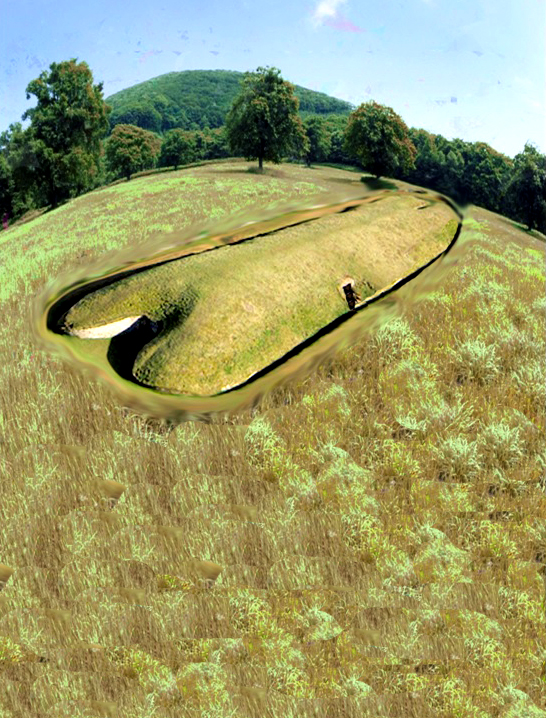
A small body of determined spirits fired by an unquenchable faith in their mission can alter the course of history. – Mahatma Gandhi
Synopsis
Careful examination reveals that these monuments are shaped like a boat with an open back end for a chamber which is similar to the helm of prehistoric and even boats of today where the crew would normally sleep.
If these monuments called ‘Long Barrows’ were located anywhere else such as Egypt, Greece or Asia Minor, then archaeologists would happily identify them as a representation of a sailing ship – but these ‘ships’ were built thousands of years before the current experts believe British boats were constructed.Recently, archaeologists in Asia Minor have realised that the world suffered massive flooding after the last Ice Age, so much so that areas like the Caspian and Black Seas doubled their volumes due to this ‘post-glacial flooding’ and this effect must have had similar results in Britain, which was considerably closer to the ice sheet. British Geology Maps show in the recent superficial soils that there was once major flooding that affected 90% of the mainland rising groundwater levels and swelling rivers.
This discovery has opened the distinct possibility that the ‘megalithic builders’ of Northern Europe were a single maritime civilisation that used boats to transport stone to build such monuments as Stonehenge, Avebury, Carnac and even Gobekli Tepe as the post-glacial flooding after the ice age affected not only Europe but even as far away as Asia Minor thus allowing people to travel throughout these extended continents via inland waterways.Archaeological findings in Britain also suggest that an archaic maritime civilisation did, in fact, exist in Northern Europe directly after the ice age.
As we have found prehistoric pictures on the walls of Stone in ‘the ancient trial’ of Ostflod in Norway showing double hull reed boats, wooden ‘mortice and tenon’ joints dated at 6250BC under the sea at Boulder Cliff in the Isle of Wight and most recently the discovery of the oldest boatyard in the world in South Wales, which launched not just boats but ‘catamarans’ possibly dating back to the end of the Ice Age some 10,000 years ago.The fact that these catamarans have now been found in Britain replicating the drawings in Norway clearly shows that an ancient maritime civilisation with advanced boat technology must have existed once upon a time.
2. Gigantic Canals – that are technically superior to even Victorian engineering.
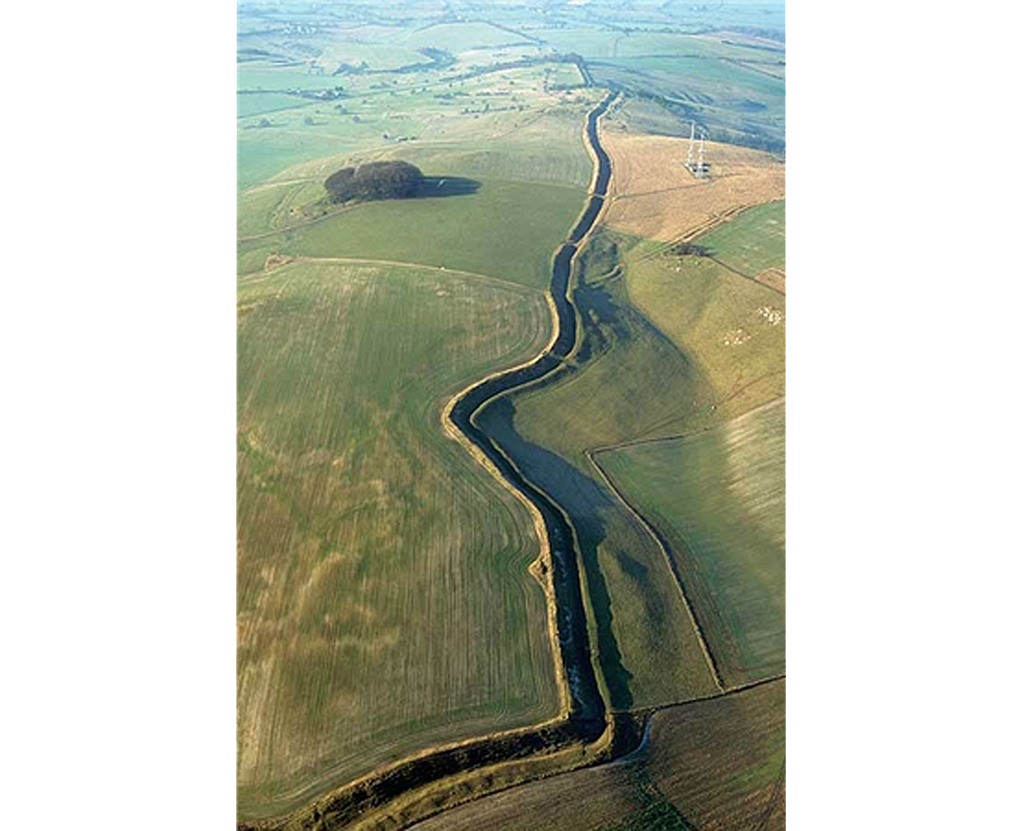
A scientific truth does not triumph by convincing its opponents and making them see the light, but rather because its opponents eventually die and a new generation grows up that is familiar with it. – Max Planck
Synopsis
A ‘Dyke’ is a word used to represent either a wall or protective mound to keep out or channel water, so why do we have such large dykes such as ‘Offa’s Dyke’ on the England/Wales border and ‘Wansdyke’ in Wiltshire on top of hill’s miles away from any form of water?
It has always been believed that some of these dykes (canals) were originally built as Medieval defensive walls, but that is far from the truth. The current dating for these monuments have been obtained by artifacts found at the bottom of their ditches, and although there are mainly artefacts of Roman origin, some stone and flint tools have also been located in or near the structures, yet archaeologists are loaved to date them as prehistoric, although we have seen similar ditches contained within monuments such as Avebury, which were undertaken thousands of years before the Romans.
This type of historical confusion can be found at two of our biggest dykes in Britain. Offa’s Dyke which is over 81 miles long and named after King Offa (730 – 796) who was supposed to have built it to defend Britain against the Welsh tribes. Sadly, for traditional archaeologists, recent investigations have shown that it was used much earlier as Roman artefacts were found at the base of one of the ditches. The other is Wansdyke in Wiltshire; this dyke is over 21 miles long; it can be in places up to 65 feet wide and 8 feet deep, but it is built in a straight line with a bank to one side, which is also believed to be a defensive structure – even though attackers could walk around the edge of the ditch without obstruction.
Newly discovered ‘Post Glacial Flooding’ shown on the British Geological Maps and investigated in recent books had indicated that these dykes were constructed in a time when superficial deposits were formed by the flooding after the last ice age when man had returned to Britain less than 10,000 years ago. The Kennet and Avon Canal is a waterway in southern England with an overall length of 87 miles (140 km), made up of two lengths of navigable river linked by a canal. The name is commonly used to refer to the entire length of the navigation rather than solely to the central canal section. From Bristol to Bath, the waterway follows the natural course of the River Avon before the canal links it to the River Kennet at Newbury, and from there to Reading on the River Thames. Quite remarkably Wansdyke was constructed just 3 km north of the Kennet and Avon canal and the new prehistoric waterway maps of Britain show it had the same result of joining the River Thames to the Bristol Channel some 6-8K years before the Victorian’s great canal system.
3. Roman ports miles away from the coast – when sea levels are apparently rising.
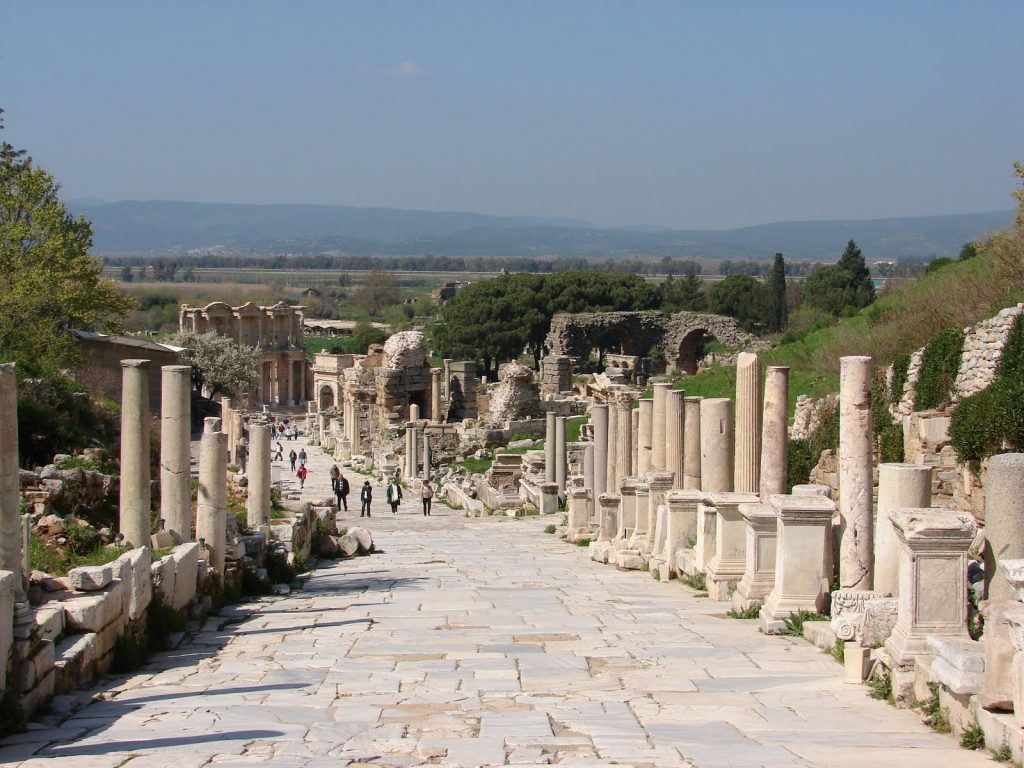
The difference between science and the fuzzy subjects is that science requires reasoning, while those other subjects merely require scholarship – Robert A Heinlein
Synopsis
When we look at old maps of Roman settlements and ports around Britain and the Mediterranean, we see that a majority are built on the coastline or waterways of these countries. This fact is not surprising as these locations would need a constant supply of goods for trading and construction. However, if we look more closely at these at these sites, it becomes apparent that some of the locations are far away from the shoreline or rivers that once supplied them. For example, Brading Roman Villa in the Isle of Wight 1. 5km from the sea and 500m from the nearest in water river, which is so small that it could hardly take a canoe let alone a Roman supply ship.
Another example is in Turkey in the Roman capital of Asia Minor, Ephesus where Queen Cleopatra sailed from Egypt to the Roman high command to meet Anthony, with a ceremony that is still enacted today for the tourists. Ephasis is a good 8km from the sea, so unless Queen Cleopatra was in need of a long walk, the shoreline has drastically changed since Roman times. The final and best example is Lewes in East Sussex, which is an incredible 15km from the coast. Moreover, this vast distance from the sea we see today is compounded by the fact that sea levels have risen by 2m over the last two thousand years, showing that the natural distance from these harbours to the coastline was even greater during the past.
The history books will tell you that this is down to either natural or manmade drainage, but why would you wish to allow a thriving harbour to silt up if it was commercially viable? In all three cases, this silting resulted in the houses or cities being completely abandoned or livelihoods lost, and the towns scaled down as a consequence. However, what is remarkable about all these locations is that they share in common factor and that the harbours were directly fed by rivers emptying into that area.These locations we built, at a time when the ground waters were high and the river flow was sufficient to flood the harbour allowing boats to sail in and out of the location.
4. Raised Beaches – that have never met the sea.
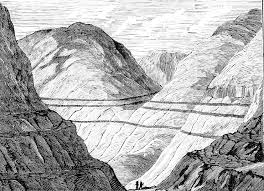
Science is a way of thinking much more than a body of knowledge. – Carl Sagan
A raised beach, marine terrace, or perched coastline is an emergent coastal land-form. Raised beaches and terraces are beaches or wave-cut platforms high above the current shoreline relative to a fall in the sea level. These are clearly seen in areas such as Norway or Scotland where the ice cap has compressed and sunk the ground surface layer (Isostatic Transformation) and has over thousands of years rebounded back to its original height.One of the classic cases of these ‘Raised Beaches’ is on the South Coast of Britain between Bournemouth and Brighton.
Unfortunately, an ice cap has never reached these areas during the last half a million years, although the raised beaches are sitting just 18” below the top soil.Theories of how this sandy layer that appears in the soil layers high in hill sediments are abundant, including British tsunamis (giant tidal waves that left sand deposits on hills).If you consult Wikipedia, it will tell you: “Tectonical and or eustatical use of marine terrace sequence”The total displacement of the shoreline relative to the age of the associated interglacial stage allows calculation of a mean uplift rate or the calculation of eustatical level at a particular time if the uplift is known.
5. Giant skeletons – found by French archaeologists now dismissed by today’s scientists.
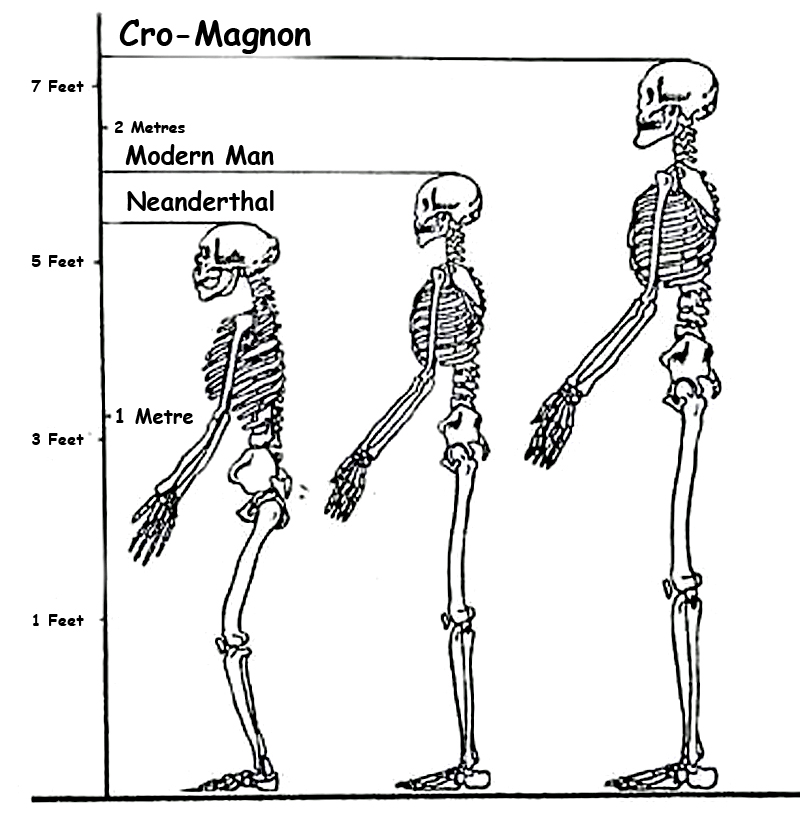
Your theory is crazy, but it’s not crazy enough to be true. – Niels Bohr
Synopsis
In 1868, parts of five skeletons were discovered in the rock shelter, located in the famous Dordogne Valley of France – they called them Cro-Magnon. Recent research over the past 20 years or so, however, has led scholars to believe that the physical dimensions of so-called ‘Cro-Magnon’ are not sufficiently different enough from modern humans to warrant a separate designation.However, the Cro-Magnon’s found under the rock shelter were over a foot taller, twice as strong, lived longer and had a brain capacity 15% greater than the people who found them, and this is why the Victorians saw them as a sub-species of man and named them accordingly.
They were the first to paint and play musical instruments.Their size and statue allowed them to become the ‘megalithic stone builders’ of prehistory who used boats to travel throughout the known world and even the Greek philosopher Plato talked about them in his dialogues. So who were these ‘Cro-Magnons’ and for what political purpose have the anthropologists killed them off?
6. Quantum of Solstice – Pythagorean maths put to use four thousand years before he was born
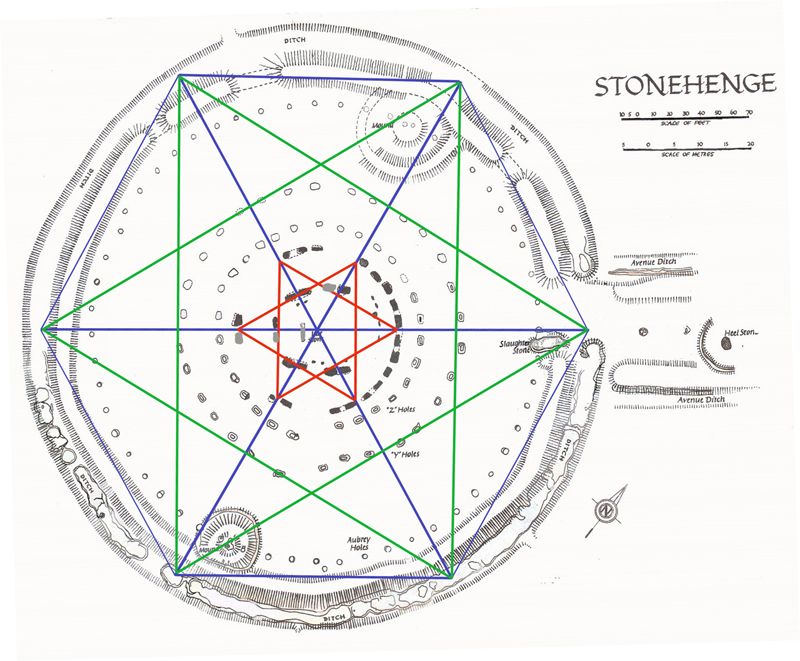
If an elderly but distinguished scientist says that something is possible, he is almost certainly right, but if he says that it is impossible, he is very probably wrong. – Arthur C. Clarke
Synopsis
If we look at the skills of the what traditional archaeologists call the ‘Megalithic People’ – the civilisation that made the first stone monuments. We notice that to achieve such grand constructions, they would have required the advanced mathematics which to date have been credited to the ancient Greeks. By undertaking a closer detailed analysis of monuments such as Stonehenge and more importantly the mathematics used to design such monuments, we can see that these constructions that are ten thousand years old were in fact, based on sound and accurate trigonometrical theory.So how was Stonehenge planned and what can we see from the ‘blueprint’ what they knew about mathematics?
Firstly, Stonehenge was built in two very separate phases – current archaeologists are confused by the monument and dating of the structure, so if you read or browse the internet you will see the ‘traditionalist’ quote three to five phases. Moreover, these phases occurred AFTER the original monument was abandoned and thousands of years later, the ritualistic Celts occupied the monument and used it to worship the Sun and the Summer Solstice as we see reenacted today during the summer solstice.The First Phase took place at 8500 BCE when our ancestors built the original ditch made up of individual pits that were cut below the ancient groundwater table level to create a moat. This moat was used with the Bluestones to bathe away infections from cuts and bites which, if left untreated, would have turned into gangrene and lethal fevers.
For Bluestones (when wet) releases chemicals, including the most potential natural antiseptic – rock salt.The most amazing aspect is the accuracy of the diameter of this moat, which is exactly 360 ft (109.73m). This length is no accident or coincidence it is the reason that our angular and trigonometrical system revolves around 360!We have 12 months a year and each has a lunar cycle that lasts (from New Moon to New Moon ) 29.53 days. We have shown in my last book ‘The Stonehenge Enigma’ that there was 56 Bluestones (2 x 28), and we can show that this was used as a very accurate (99.8%) moon and eclipse calendar, which could compensate for the 0.47 day difference between the moon cycle and a 30 day standard cycle.It is, therefore, no surprise that the most ancient of calendars are 12 x 30 = 360 days in length.In history, we know that in the eighth century B.C.E., civilizations all over the world either discarded or modified their old 360-day calendars. The 360-day calendars had been in use for the greater part of the past millenniums. In many places, month lengths immediately after that change were not fixed but were based instead on observation of the sky.
7. Recent Landscape Flooding & Storms – the secret our ancestors knew about Britain’s weather

Synopsis
“Flooding is the major and most frequently recurring natural disaster in Britain. However, it is not a new phenomenon and geological information show where it has happened in the last 10,000 years” – British Geological Society.
BSG has published maps showing the remains of ancient waterways evidenced by the deposits of clay, sand and gravel; these are termed as “ alluvial deposits,” and they cover 10% of the mainland of Britain showing it was flooded directly after the last Ice Age – but there are further deposits of all a substances called ‘head’ made up also of Clay, sand and gravel, which show, in reality, that 40% of the land surface was flooded directly after the last ice age – the consequence is that the so-called ‘hunter/gathers’ could not have existed as portrayed in our history books, unless he had a boat.So why are these obvious geological features ignored by archaeologists and what could it mean to the history of Ancient Britain?
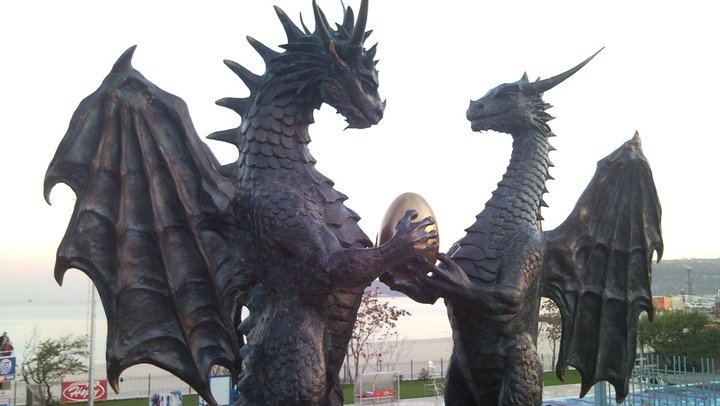
Look deep into nature and then you will understand everything better. – Albert Einstein
Synopsis
A dragon is a legendary creature, typically with serpentine or reptilian traits, that features in the myths from many cultures. According to our popular history books, there are two distinct cultural traditions of dragons: the European dragon derived from folklore and ultimately related to Greek and Middle Eastern mythologies, and the Chinese dragon, with counterparts in Japan, Korea and other East Asian countries.
However, there are also Dragons in Central America and Africa, which are not as well known.But how can these groups of people separated by tens of thousands of miles dream up a ‘non-existent’ creature with the same look and features?Dragons appear in Wales, England, Greece, Slovakia, Indian, Persia, Asia Minor, Japan, China, Vietnam, and Australia and let us not forget (like the history books) Mexico, Central America, Ethiopia and Egypt.This actually places dragons on every continent in the World!The association of the serpent with a monstrous opponent overcame by a heroic deity has its roots in the mythology of the Ancient Near East, including Canaanite (Hebrew, Ugaritic), Hittite and Mesopotamian. Humbaba, the fire-breathing dragon-fanged beast first described in the Epic of Gilgamesh is sometimes described as a dragon with Gilgamesh playing the part of dragon-slayer.
The legless serpent (Chaoskampf) motif entered Greek mythology and ultimately Christian mythology, although the serpent motif may already be part of prehistoric Indo-European mythology as well, based on comparative evidence of Indic and Germanic material.Although dragons occur in many legends around the world, different cultures have varying stories about monsters that have been grouped together under the dragon label. Some dragons are said to breathe fire or to be poisonous, such as in the Old English poem Beowulf. They are commonly portrayed as serpentine or reptilian, hatching from eggs and possessing typically scaly or feathered bodies. They are sometimes portrayed as hoarding treasure.
9. On Sunken land of the North Sea – was this the world’s oldest and greatest civilisation?
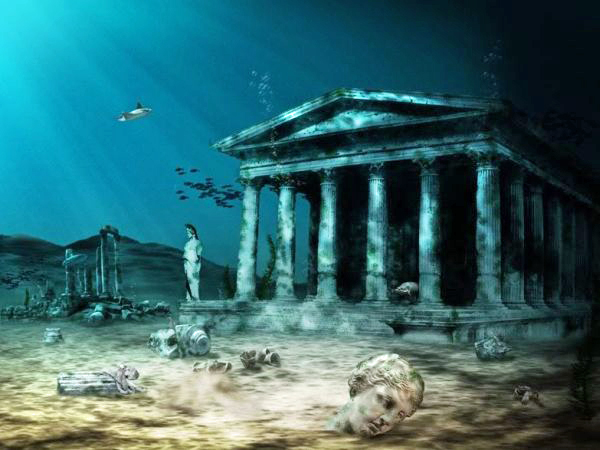
“The sea, once it casts its spell, holds one in its net of wonder forever”. – Jacques Yves Cousteau
Synopsis
After the last ice age, the ‘great melt’ flooded the landscape of Britain for over ten thousand years. This flooding started a chain reaction and as a consequence, the sea level slowly increased and vast areas of land were lost including a land mass known as ‘Doggerland.’Throughout the 19th century, oyster dredgers working the shallow waters off the north east coast of England recorded frequent finds of animal bones caught up in their nets.
These discover- is became a regular occurrence as the fishing technology increased and the trawlers at a later date and in deeper waters of the North Sea also found traces of civilisation and a lost continent. Sadly, the location and accuracy are rarely recorded with any degree of accuracy; this material appeared to come from some areas within the North Sea.One area where the greatest number of finds discovered is known as the ‘Dogger Bank’ which lies just 90km – 110km (60-70 miles) from the coast of the British Isles. This shoal (a shoal, sand- bar, sandbank or gravel bar is a somewhat linear landform within or extending into a body of water, typically composed of sand, silt or small pebbles.) rises about 45m (150 ft) above the North Sea bed, to the north it plunges into deeper water and forms a subterranean plateau covering 17,600 sq. km. (6,800 miles) With a maximum dimension being 260km (160 miles) from North to South and 95 km (60 miles) from East to West.
Over time, the number of finds reduced as the same area was dredged day after day and any artefacts sitting on the surface would have been scooped up and either returned as a curiosity or in a majority of the time just thrown back in a different location.Even so, items such as; bear, wolf, hyena, bison, woolly rhino, mammoth, beaver, walrus, elk, deer and most importantly horse has been collected. This precious collection of findings gives us a fantastic insight into what Doggerland looked like, the environment that supported these animals and the climate of this unique area of the world.It would be impossible to talk about Doggerland and its environment without understanding if there was a written history of a land that flooded thousands of years ago, and this comes in the works of the ancient Greek Philosopher Plato.
Over the years, Atlantis has grown to be both a legend and the source of many science fictions; this is neither correct nor helpful in tracing the history of humanity, as it moves the debate from scientific observation to fantasy and the degrading of the most important time in our history. Plato is a source of credible information as he is not a ‘story teller’ like some other historical writers. He is fundamentally a philosopher, whose writings are still studied even now, some 2,000 years after his death at the most famous and prestigious universities throughout the world. This man is not prone to fantasy or exaggeration, his writings, therefore, must be accepted as true evidence that once in the distant past a great ancient civilisation, did, in fact, exist, and that they changed the course of humanity in ways which I believe we do not fully understand to date.
10. Alexander the Great sailed into India – where no rivers now exist.
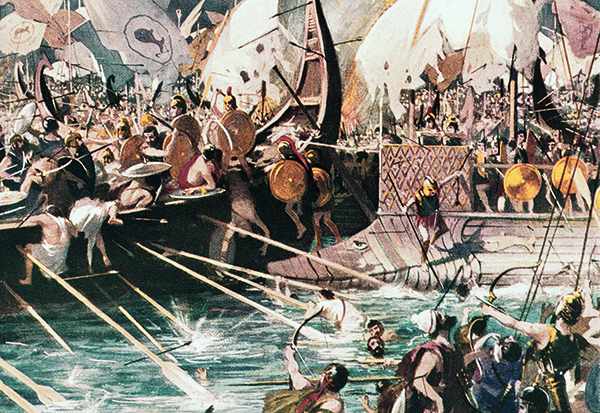
I came, I saw, I conquered – Julius Caesar
Synopsys
The Indian campaign of Alexander the Great began in 326 BC. Alexander was born July20, 356 B.C. in Pella, in the Kingdom of Macedonia. During his leadership, he united the Greek city-states and led the Corinthian League. He also became the king of Persia, Babylon and Asia, and created Macedonian colonies in Iran. After conquering the Achaemenid Empire of Persia, the Macedonian king (and now high king of the Persian Empire) Alexander launched a campaign in north west India (what is now Pakistan.) The Battle of the Hydaspes river against King Porus in Punjab is considered by many historians, as the most costly battle that the armies of Alexander fought.
The rationale for this campaign is usually said to be Alexander’s desire to conquer the entire known world, which the Greeks thought ended in north-western India. While considering the conquests of Carthage and Rome, Alexander died in Babylon on June 13, 323 BC. In 321 BC, two years after Alexander’s death, Chandragupta Maurya of Magadha, founded the Maurya Empire in India.The Battle of the Hydaspes River was fought by Alexander in July 326 BC against King Raja Purushottama (Poros) a Kshatriya on the Hydaspes River (Jhelum River) in the Punjab of Pakistan, near Bhera.
The Hydaspes was the last major battle fought by Alexander. The main train went into modern-day Pakistan through the Khyber Pass, but a smaller force under the personal command of Alexander went through the northern route, resulting in the Siege of Aornos along the way. In early spring of the next year, he combined his forces and allied with Taxiles (also Ambhi), the King of Taxila, against his neighbor, the King of Hydaspes.
Puru was a great King of Indus/ Asiatic continent. Arrian writes about Porus, in his own words “One of the Indian Kings called Porus a man remarkable alike for his strength and noble courage, on hearing the report about Alexander, began to prepare for the inevitable.Accordingly, when hostilities broke out, he ordered his army to attack Macedonians from whom he demanded their king, as if he was his private enemy. Alexander lost no time in joining battle, but his horse being wounded in the first charge; he fell headlong to the ground, and was saved by his attendants who hastened up to his assistance.” Porus drew up on the south bank of the Jhelum River, and was set to repel any crossings. The Jhelum River was deep and fast enough that any opposed crossing would probably doom the entire attacking force.
11. Antler Picks that built ancient monuments – although only one has been found at the largest stone circle in the world.
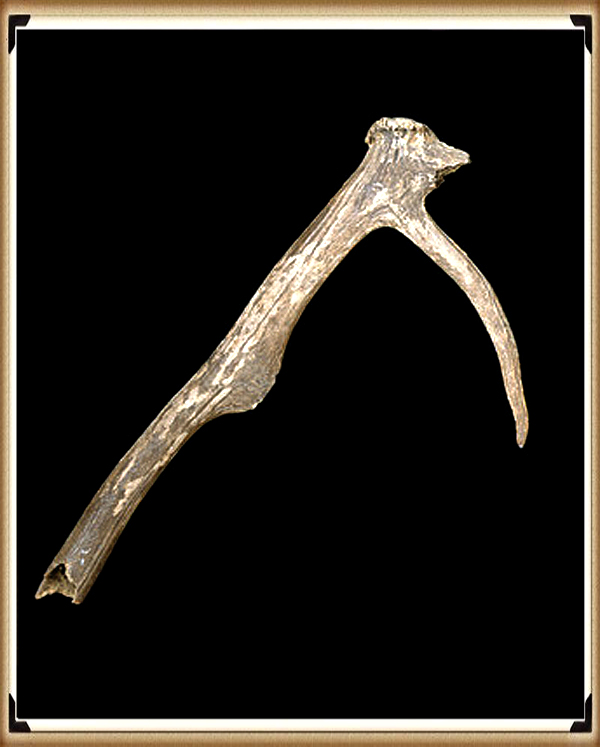
Science never solves problems without creating ten more – George Bernard Shaw
Synopsis
According to the history books, our ancestors built the great and numerous prehistoric sites using basic tools such as antler picks to cut the chalk bedrock and animal shoulder blades as a shovel.Some of these ancient constructions moved over half a million tonnes of chalk to create the likes of Silbury Hill – the largest prehistoric mound in Europe and Avebury with its massive 70 foot wide and 36 foot deep ditches that took eighteen million man-hours to build over very many years.Yet in Avebury only one buried antler has ever been found and less than a handful of tiny fragments found inside Silbury Hill.So how were these monuments really built and why has this false evidence made its way into our history books?
12. Columbus was the first Western Man to reach America – Yet bones and tools suggest that Europeans sail there ten thousand years earlier.
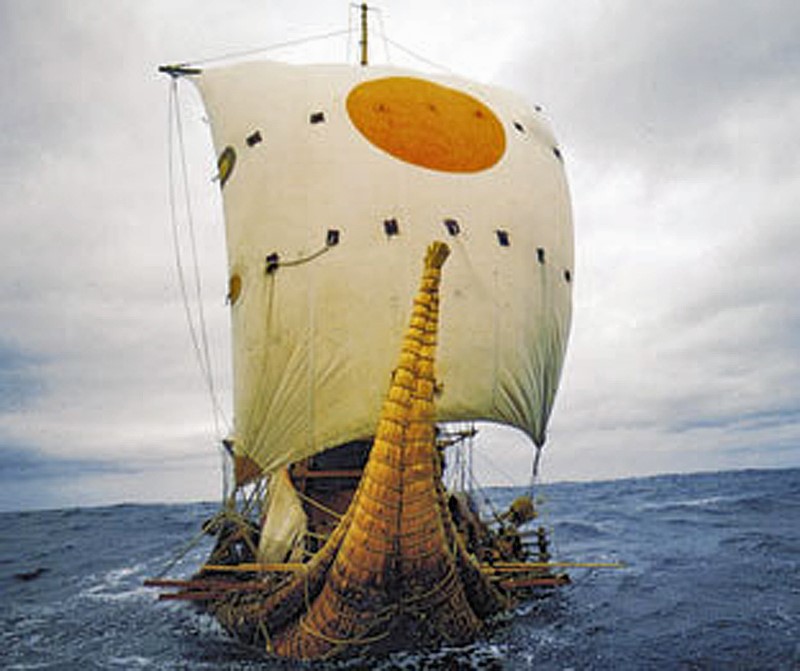
“We would like to live as we once lived, but history will not permit it” – John F. Kennedy
Synopsys
A blood type (also called a blood group) is a classification of blood-based on the presence or absence of inherited antigenic substances on the surface of red blood cells (RBCs). These antigens may be proteins, carbohydrates, glycoproteins, or glycolipids, depending on the blood group system. Some of these antigens are also present on the surface of other types of cells of various tissues. Several of these red blood cell surface antigens can stem from one allele (or very closely linked genes) and collectively form a blood group system. Blood types are inherited and represent contributions from both parents. A total of 32 human blood group systems is now recognized by the International Society of Blood Transfusion (ISBT).
The two most important ones are ABO and the RhD antigen; they determine someone’s blood type (A, B, AB and O, with + and – denoting RhD status).Many pregnant women carry a fetus with a blood type different from their own, and the mother can form antibodies against fetal RBCs. Sometimes these maternal antibodies are IgG, a small immunoglobulin, which can cross the placenta and cause hemolysis of fetal RBCs, which in turn can lead to hemolytic disease of the newborn called erythroblastosis fetalis; an illness of low fetal blood counts that ranges from mild to severe.
Sometimes this is lethal for the fetus; in these cases, it is called hydrops fetalis.One of the Greatest Mysteries in Anthropology is how the A Rh neg blood groups originated in North America.Blood groups are a good method to detect population migration in conjunction with modern DNA Haplogroups, as the former has been identified for over 100 years, unlike the modern method.An individual either has or does not have, the “Rhesus factor” on the surface of their red blood cells. This term refers only to the most immunogenic D antigen of the Rh blood group system, or the Rh- blood group system. The status is usually indicated by Rh positive (Rh+ does have the D antigen), or Rh negative (Rh- does not have the D antigen) suffix to the ABO blood type.
13. Was Troy really located in Turkey – if so why did it take Odysseus ten years to travel 200 miles get home to Greece.
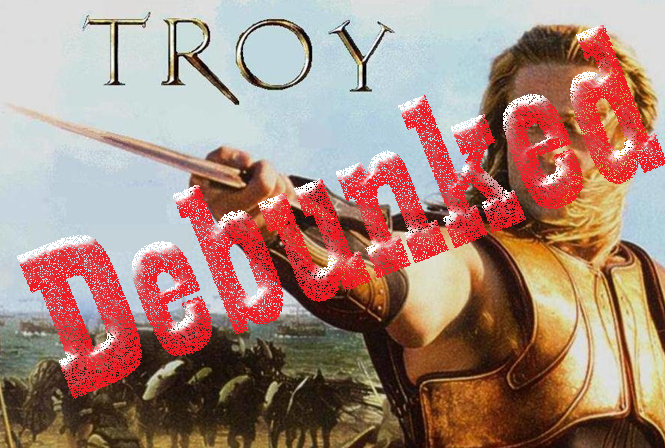
The very ink with which history is written is merely fluid prejudice. – Mark Twain
Synopsys
Where Troy Once Stood is a book by Iman Wilkens, that argues that the city of Troy was located in England and the Trojan War was fought between groups of Celts.The standard view is that Troy is located near the Dardanelles in Turkey. Wilkens claims that Homer’s Iliad and Odyssey, though products of ancient Greek culture, is originally orally transmitted epic poems from Western Europe. Wilkens disagrees with conventional ideas about the historicity of the Iliad and the location and participants of the Trojan War.Copies of his book ranked high on Bookfinder’s list of most-wanted out of print books until 2005, when the latest revised edition was published. His work has had little impact on professional scholars.
Anthony Snodgrass, Emeritus Professor of Classical Archaeology at Cambridge University, has named Wilkens as an example of an “infinitely less-serious” writer.So what evidence does Wilkens use to prove that Troy was in Northern Europe?Wilkens argues that Troy was located in England on the Gog Magog Downs in Cambridgeshire. He believes that Celts living there were attacked around 1200 BC by fellow Celts from the continent to battle over access to the tin mines in Cornwall as tin was a very important component for the production of bronze.Wilkens writes that there are similarities between the river names in the Iliad and present-day England: “Homer names no less than fourteen rivers in the region of Troy.” The rivers Thames, Cam, Great Ouse and Little Ouse, to name a few, can respectively be identified as Temese, Scamander, Simois and Satniois, according to Wilkens.
The revised edition of 2005 contains a “reconstruction” of the Trojan battlefield in Cambridgeshire.13 ancient things that don’t make sense in History – TroyAccording to Wilkens, St Michael’s Mount is the site of Scylla and CharybdisWilkens further hypothesises that the Sea Peoples found in the Late Bronze Age Mediterranean were Celts, who settled in Greece and the Aegean Islands as the Achaeans and Pelasgians. They named new cities after the places they had come from, (similar to the migration of many place names to North America), and brought the oral poems that formed the basis of the Iliad and the Odyssey with them from Western Europe. Wilkens writes that, after being orally transmitted for about four centuries, the poems were translated and written down in Greek around 750 BC.
The Greeks, who had forgotten about the origins of the poems, located the stories in the Mediterranean, where many Homeric place names could be found, but the poems’ descriptions of towns, islands, sailing directions and distances were not altered to fit the reality of the Greek setting. He also writes that “It also appears that Homer’s Greek contains a large number of loan words from western European languages, more often from Dutch rather than English, French or German.” These languages are considered by linguists to have not existed until around 1000 years after Homer.Wilkens argues that the Atlantic Ocean was the theatre for the Odyssey instead of the Mediterranean.For example he locates Scylla and Charybdis at present day St Michael’s Mount.
Further Reading
For information about British Prehistory, visit www.prehistoric-britain.co.uk for the most extensive archaeology blogs and investigations collection, including modern LiDAR reports. This site also includes extracts and articles from the Robert John Langdon Trilogy about Britain in the Prehistoric period, including titles such as The Stonehenge Enigma, Dawn of the Lost Civilisation and the ultimate proof of Post Glacial Flooding and the landscape we see today.
Robert John Langdon has also created a YouTube web channel with over 100 investigations and video documentaries to support his classic trilogy (Prehistoric Britain). He has also released a collection of strange coincidences that he calls ‘13 Things that Don’t Make Sense in History’ and his recent discovery of a lost Stone Avenue at Avebury in Wiltshire called ‘Silbury Avenue – the Lost Stone Avenue’.
Langdon has also produced a series of ‘shorts’, which are extracts from his main body of books:
For active discussions on the findings of the TRILOGY and recent LiDAR investigations that are published on our WEBSITE, you can join our and leave a message or join the debate on our Facebook Group.
Other Blogs
1
a
- AI now Supports – Homo Superior
- AI now supports my Post-Glacial Flooding Hypothesis
- Alexander the Great sailed into India – where no rivers exist today
- Ancient Prehistoric Canals – The Vallum
- Ancient Secrets of Althorp – debunked
- Antler Picks built Ancient Monuments – yet there is no real evidence
- Antonine Wall – Prehistoric Canals (Dykes)
- Archaeological ‘pulp fiction’ – has archaeology turned from science?
- Archaeological Pseudoscience
- Archaeology in the Post-Truth Era
- Archaeology: A Bad Science?
- Archaeology: A Harbour for Fantasists?
- Archaeology: Fact or Fiction?
- Archaeology: The Flaws of Peer Review
- Archaeology’s Bayesian Mistake: Stop Averaging the Past
- Are Raised Beaches Archaeological Pseudoscience?
- Atlantis Found: The Mathematical Proof That Plato’s Lost City Was Doggerland
- ATLANTIS: Discovery with Dan Snow Debunked
- Avebury Ditch – Avebury Phase 2
- Avebury Post-Glacial Flooding
- Avebury through time
- Avebury’s great mystery revealed
- Avebury’s Lost Stone Avenue – Flipbook
b
- Battlesbury Hill – Wiltshire
- Beyond Stone and Bone: Rethinking the Megalithic Architects of Northern Europe
- BGS Prehistoric River Map
- Blackhenge: Debunking the Media misinterpretation of the Stonehenge Builders
- Brain capacity (Cro-Magnon Man)
- Brain capacity (Cro-Magnon Man)
- Britain’s First Road – Stonehenge Avenue
- Britain’s Giant Prehistoric Waterways
- British Roman Ports miles away from the coast
c
- Caerfai Promontory Fort – Archaeological Nonsense
- Car Dyke – ABC News PodCast
- Car Dyke – North Section
- CASE STUDY – An Inconvenient TRUTH (Craig Rhos Y Felin)
- Case Study – River Avon
- Case Study – Woodhenge Reconstruction
- Chapter 2 – Craig Rhos-Y-Felin Debunked
- Chapter 2 – Stonehenge Phase I
- Chapter 2 – Variation of the Species
- Chapter 3 – Post Glacial Sea Levels
- Chapter 3 – Stonehenge Phase II
- Chapter 7 – Britain’s Post-Glacial Flooding
- Cissbury Ring through time
- Cro-Magnon Megalithic Builders: Measurement, Biology, and the DNA
- Cro-Magnons – An Explainer
d
- Darwin’s Children – Flipbook
- Darwin’s Children – The Cro-Magnons
- Dawn of the Lost Civilisation – Flipbook
- Dawn of the Lost Civilisation – Introduction
- Digging for Britain – Cerne Abbas 1 of 2
- Digging for Britain Debunked – Cerne Abbas 2
- Digging Up Britain’s Past – Debunked
- DLC Chapter 1 – The Ascent of Man
- Durrington Walls – Woodhenge through time
- Durrington Walls Revisited: Platforms, Fish Traps, and a Managed Mesolithic Landscape
- Dyke Construction – Hydrology 101
- Dykes Ditches and Earthworks
- DYKES of Britain
e
f
g
h
- Hadrian’s Wall – Military Way Hoax
- Hadrian’s Wall – the Stanegate Hoax
- Hadrian’s Wall LiDAR investigation
- Hambledon Hill – NOT an ‘Iron Age Fort’
- Hayling Island Lidar Maps
- Hidden Sources of Ancient Dykes: Tracing Underground Groundwater Fractals
- Historic River Avon
- Hollingsbury Camp Brighton
- Hollows, Sunken Lanes and Palaeochannels
- Homo Superior – Flipbook
- Homo Superior – History’s Giants
- How Lidar will change Archaeology
i
l
m
- Maiden Castle through time
- Mathematics Meets Archaeology: Discovering the Mesolithic Origins of Car Dyke
- Mesolithic River Avon
- Mesolithic Stonehenge
- Minerals found in Prehistoric and Roman Quarries
- Mining in the Prehistoric to Roman Period
- Mount Caburn through time
- Mysteries of the Oldest Boatyard Uncovered
- Mythological Dragons – a non-existent animal that is shared by the World.
o
- Offa’s Dyke Flipbook
- Old Sarum Lidar Map
- Old Sarum Through Time…………….
- On Sunken Lands of the North Sea – Lived the World’s Greatest Civilisation.
- OSL Chronicles: Questioning Time in the Geological Tale of the Avon Valley
- Oswestry LiDAR Survey
- Oswestry through time
- Oysters in Archaeology: Nature’s Ancient Water Filters?
p
- Pillow Mounds: A Bronze Age Legacy of Cremation?
- Post Glacial Flooding – Flipbook
- Prehistoric Burial Practices of Britain
- Prehistoric Canals – Wansdyke
- Prehistoric Canals – Wansdyke
- Prehistoric Canals (Dykes) – Great Chesters Aqueduct (The Vallum Pt. 4)
- Prehistoric Canals (Dykes) – Hadrian’s Wall Vallum (pt 1)
- Prehistoric Canals (Dykes) – Offa’s Dyke (Chepstow)
- Prehistoric Canals (Dykes) – Offa’s Dyke (LiDAR Survey)
- Prehistoric Canals (Dykes) – Offa’s Dyke Survey (End of Section A)
- Prehistoric Canals (Dykes) – Wansdyke (4)
- Prehistoric Canals Wansdyke 2
- Professor Bonkers and the mad, mad World of Archaeology
r
- Rebirth in Stone: Decrypting the Winter Solstice Legacy of Stonehenge
- Rediscovering the Winter Solstice: The Original Winter Festival
- Rethinking Ancient Boundaries: The Vallum and Offa’s Dyke”
- Rethinking Ogham: Could Ireland’s Oldest Script Have Begun as a Tally System?
- Rethinking The Past: Mathematical Proof of Langdon’s Post-Glacial Flooding Hypothesis
- Revolutionising History: Car Dyke Unveiled as Prehistoric & the Launch of FusionBook 360
- Rising Evidence, Falling Rivers: The Real Story of Europe’s First Farmers
- Rivers of the Past Were Higher: A Fresh Perspective on Prehistoric Hydrology
s
- Sea Level Changes
- Section A – NY26SW
- Section B – NY25NE & NY26SE
- Section C – NY35NW
- Section D – NY35NE
- Section E – NY46SW & NY45NW
- Section F – NY46SE & NY45NE
- Section G – NY56SW
- Section H – NY56NE & NY56SE
- Section I – NY66NW
- Section J – NY66NE
- Section K – NY76NW
- Section L – NY76NE
- Section M – NY87SW & NY86NW
- Section N – NY87SE
- Section O – NY97SW & NY96NW
- Section P – NY96NE
- Section Q – NZ06NW
- Section R – NZ06NE
- Section S – NZ16NW
- Section T – NZ16NE
- Section U – NZ26NW & NZ26SW
- Section V – NZ26NE & NZ26SE
- Silbury Avenue – Avebury’s First Stone Avenue
- Silbury Hill
- Silbury Hill / Sanctuary – Avebury Phase 3
- Somerset Plain – Signs of Post-Glacial Flooding
- South Cadbury Castle – Camelot
- Statonbury Camp near Bath – an example of West Wansdyke
- Stone me – the druids are looking the wrong way on Solstice day
- Stone Money – Credit System
- Stone Transportation and Dumb Censorship
- Stonehenge – Monument to the Dead
- Stonehenge Hoax – Dating the Monument
- Stonehenge Hoax – Round Monument?
- Stonehenge Hoax – Summer Solstice
- Stonehenge LiDAR tour
- Stonehenge Phase 1 — Britain’s First Monument
- Stonehenge Phase I (The Stonehenge Landscape)
- Stonehenge Solved – Pythagorean maths put to use 4,000 years before he was born
- Stonehenge Stone Transportation
- Stonehenge Through Time
- Stonehenge, Doggerland and Atlantis connection
- Stonehenge: Discovery with Dan Snow Debunked
- Stonehenge: The Worlds First Computer
- Stonehenge’s The Lost Circle Revealed – DEBUNKED
t
- Ten Reasons Why Car Dyke Blows Britain’s Earthwork Myths Out of the Water
- Ten Things You Didn’t Know About Britain’s Prehistoric Flooded Past
- Ten thousand year old boats found on Northern Europe’s Hillsides
- Ten thousand-year-old boats found on Northern Europe’s Hillsides
- The “Hunter-Gatherer” Myth: Why It’s Time to Bury This Outdated Term
- The Ancient Mariners – Flipbook
- The Ancient Mariners – Prehistoric seafarers of the Mesolithic
- The Beringian Migration Myth: Why the Peopling of the Americas by Foot is Mathematically and Logistically Impossible
- The Bluestone Enigma
- The Cro-Magnon Cover-Up: How DNA and PR Labels Erased Our Real Ancestry
- The Dolmen and Long Barrow Connection
- The Durrington Walls Hoax – it’s not a henge?
- The Dyke Myth Collapses: Excavation and Dating Prove Britain’s Great Dykes Are Prehistoric Canals
- The First European Smelted Bronzes
- The Fury of the Past: Natural Disasters in Historical and Prehistoric Britain
- The Giant’s Graves of Cumbria
- The Giants of Prehistory: Cro-Magnon and the Ancient Monuments
- The Great Antler Pick Hoax
- The Great Chichester Hoax – A Bridge too far?
- The Great Dorchester Aqueduct Hoax
- The Great Farming Hoax – (Einkorn Wheat)
- The Great Farming Migration Hoax
- The Great Hadrian’s Wall Hoax
- The Great Iron Age Hill Fort Hoax
- The Great Offa’s Dyke Hoax
- The Great Prehistoric Migration Hoax
- The Great Stone Transportation Hoax
- The Great Stonehenge Hoax
- The Great Wansdyke Hoax
- The Henge and River Relationship
- The Logistical Impossibility of Defending Maiden Castle
- The Long Barrow Mystery
- The Long Barrow Mystery: Unraveling Ancient Connections
- The Lost Island of Avalon – revealed
- The Maiden Way Hoax – A Closer Look at an Ancient Road’s Hidden History
- The Maths – LGM total ice volume
- The Mystery of Pillow Mounds: Are They Really Medieval Rabbit Warrens?
- The Old Sarum Hoax
- The Oldest Boat Yard in the World found in Wales
- The Perils of Paradigm Shifts: Why Unconventional Hypotheses Get Branded as Pseudoscience
- The Post-Glacial Flooding Hypothesis – Flipbook
- The Post-Glacial Flooding Theory
- The Problem with Hadrian’s Vallum
- The Rise of the Cro-Magnon (Homo Superior)
- The Roman Military Way Hoax
- The Silbury Hill Lighthouse?
- The Stonehenge Avenue
- The Stonehenge Avenue
- The Stonehenge Code: Unveiling its 10,000-Year-Old Secret
- The Stonehenge Enigma – Flipbook
- The Stonehenge Enigma: What Lies Beneath? – Debunked
- The Stonehenge Hoax – Bluestone Quarry Site
- The Stonehenge Hoax – Flipbook
- The Stonehenge Hoax – Moving the Bluestones
- The Stonehenge Hoax – Periglacial Stripes
- The Stonehenge Hoax – Station Stones
- The Stonehenge Hoax – Stonehenge’s Location
- The Stonehenge Hoax – The Ditch
- The Stonehenge Hoax – The Slaughter Stone
- The Stonehenge Hoax – The Stonehenge Layer
- The Stonehenge Hoax – Totem Poles
- The Stonehenge Hoax – Woodhenge
- The Stonehenge Hospital
- The Subtropical Britain Hoax
- The Troy, Hyperborea and Atlantis Connection
- The Vallum @ Hadrian’s Wall – it’s Prehistoric!
- The Vallum at Hadrian’s Wall (Summary)
- The Woodhenge Hoax
- Three Dykes – Kidland Forest
- Top Ten misidentified Fire Beacons in British History
- Troy Debunked
- TSE – DVD Barrows
- TSE DVD – An Inconvenient Truth
- TSE DVD – Antler Picks
- TSE DVD – Avebury
- TSE DVD – Durrington Walls & Woodhenge
- TSE DVD – Dykes
- TSE DVD – Epilogue
- TSE DVD – Stonehenge Phase I
- TSE DVD – Stonehenge Phase II
- TSE DVD – The Post-Glacial Hypothesis
- TSE DVD Introduction
- TSE DVD Old Sarum
- Twigs, Charcoal, and the Death of the Saxon Dyke Myth
w
- Wansdyke – Short Film
- Wansdyke East – Prehistoric Canals
- Wansdyke Flipbook
- Wansdyke LiDAR Flyover
- Wansdyke: A British Frontier Wall – ‘Debunked’
- Was Columbus the first European to reach America?
- White Sheet Camp
- Why a Simple Fence Beats a Massive Dyke (and What That Means for History)
- Windmill Hill – Avebury Phase 1
- Winter Solstice – Science, Propaganda and Indoctrination
- Woodhenge – the World’s First Lighthouse?




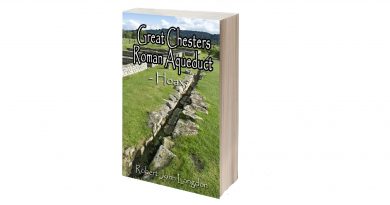
Pingback: 13 Ancient Things that don’t make sense in History (PB) – Author's Book Listing
Pingback: The Stonehenge Hoax - Bluestone Quarry Site - Prehistoric Britain
Pingback: The Durrington Walls Hoax - it's not a henge? - Prehistoric Britain
Pingback: The Stonehenge Hoax - Moving the Bluestones - Prehistoric Britain
Pingback: The Stonehenge Hoax - Totem Poles - Prehistoric Britain
Pingback: Hollingsbury Camp Brighton - Prehistoric Britain
Pingback: The Stonehenge Avenue - Prehistoric Britain
Pingback: Mesolithic Stonehenge - Prehistoric Britain
Pingback: Archaeological pulp fiction - has archaeology turned from science? - Prehistoric Britain
Pingback: The First European Smelted Bronzes - Prehistoric Britain
Pingback: Ten thousand-year-old boats found on Northern Europe's Hillsides - Prehistoric Britain
Pingback: Case Study - River Avon - Prehistoric Britain
Pingback: TSE DVD - Introduction - Prehistoric Britain
Pingback: Stonehenge Hoax – Summer Solstice - Prehistoric Britain
Pingback: The Great Stonehenge Hoax - Prehistoric Britain
Pingback: The Silbury Hill Lighthouse? - Prehistoric Britain
Pingback: Troy Debunked - Prehistoric Britain
Pingback: Hadrian's Wall - Military Way Hoax - Prehistoric Britain
Pingback: Wansdyke - Short Film - Prehistoric Britain
Pingback: Archaeological Pseudoscience - Prehistoric Britain
Pingback: Section V - NZ26NE & NZ26SE - Prehistoric Britain
Pingback: Section U - NZ26NW & NZ26SW - Prehistoric Britain
Pingback: Chapter 3 – Stonehenge Phase II - Prehistoric Britain
Pingback: Section S - NZ16NW - Prehistoric Britain
Pingback: Section O - NY97SW & NY96NW - Prehistoric Britain
Pingback: The Henge and River Relationship - Prehistoric Britain
Pingback: Section N - NY87SE - Prehistoric Britain
Pingback: Section M - NY87SW & NY86NW - Prehistoric Britain
Pingback: Section L - NY76NE - Prehistoric Britain
Pingback: Chapter 2 – Craig Rhos-Y-Felin Debunked - Prehistoric Britain
Pingback: Chapter 3 – Post Glacial Sea Levels - Prehistoric Britain
Pingback: Section I - NY66NW - Prehistoric Britain
Pingback: Section K - NY76NW - Prehistoric Britain
Pingback: Section J - NY66NE - Prehistoric Britain
Pingback: Section H - NY56NE & NY56SE - Prehistoric Britain
Pingback: Chapter 2 – Variation of the Species - Prehistoric Britain
Pingback: Hadrian’s Wall LiDAR investigation - Prehistoric Britain
Pingback: Prehistoric Canals (Dykes) - Roman Military Way - Prehistoric Britain
Pingback: Section A – NY26SW - Prehistoric Britain
Pingback: Section B – NY25NE & NY26SE - Prehistoric Britain
Pingback: Section C – NY35NW - Prehistoric Britain
Pingback: Section D – NY35NE - Prehistoric Britain
Pingback: Section E – NY46SW & NY45NW - Prehistoric Britain
Pingback: Chapter 2 – Stonehenge Phase I - Prehistoric Britain
Pingback: Ancient Secrets of Althorp - debunked - Prehistoric Britain
Pingback: The Giant's Graves of Cumbria - Prehistoric Britain
Pingback: The Problem with Hadrian's Vallum - Prehistoric Britain
Pingback: The Great Wansdyke Hoax - Prehistoric Britain
Pingback: 13 things that don't make sense about Waun Mawn - Stonehenge - Prehistoric Britain
Pingback: Statonbury Camp near Bath - an example of West Wansdyke - Prehistoric Britain
Pingback: Antonine Wall - Prehistoric Canals (Dykes) - Prehistoric Britain
Pingback: The Rivers of the Past were Higher – an Idiot’s Guide - Prehistoric Britain
Pingback: Extreme Weather and Ancient Subterranean Shelters - Prehistoric Britain
Pingback: The Great Farming Hoax - (Einkorn Wheat) - Prehistoric Britain
Pingback: Revolutionising History: Car Dyke Unveiled as Prehistoric & the Launch of FusionBook 360 - Prehistoric Britain
Pingback: Debunking the Media Misinterpretation of the "Black Stonehenge Builders" Reports - Prehistoric Britain
Pingback: Archaeology: The Flaws of Peer Review - Prehistoric Britain
Pingback: Prehistoric Canals (Dykes) - Offa's Dyke (Chepstow) - Prehistoric Britain
Pingback: Britain's Giant Prehistoric Waterways - Prehistoric Britain
Pingback: Newgrange - Monument or Disneyland? - Prehistoric Britain
Pingback: Prehistoric Canals (Dykes) - Wansdyke (4) - Prehistoric Britain
Pingback: The Perils of Paradigm Shifts: Why Unconventional Hypotheses Get Branded as Pseudoscience - Prehistoric Britain
Pingback: From the Rhône to Wansdyke: The Case for a Standardised Canal Boat in Prehistoric Britain - Prehistoric Britain
Pingback: Dyke Construction - Hydrology 101 - Prehistoric Britain
Pingback: 13 Things You Didn’t Know About Hillforts — The Real Story Behind Britain’s Ancient Earthworks - Prehistoric Britain
Pingback: Silbury Avenue - Avebury's First Stone Avenue - Prehistoric Britain
Pingback: The Stonehenge Code: Unveiling its 10,000-Year-Old Secret - Prehistoric Britain
Pingback: Rethinking The Past: Mathematical Proof of Langdon's Post-Glacial Flooding Hypothesis - Prehistoric Britain
Pingback: The “Hunter-Gatherer” Myth: Why It’s Time to Bury This Outdated Term - Prehistoric Britain
Pingback: The Beringian Migration Myth: Why the Peopling of the Americas by Foot is Mathematically and Logistically Impossible - Prehistoric Britain
Pingback: Ten Things You Didn’t Know About Britain’s Prehistoric Flooded Past - Prehistoric Britain
Pingback: Stonehenge Phase 1 — Britain's First Monument - Prehistoric Britain
Pingback: - Prehistoric Britain
Pingback: Cro-Magnons - An Explainer - Prehistoric Britain
Pingback: The Great Farming Migration Hoax - Prehistoric Britain
Pingback: Ten Reasons Why Car Dyke Blows Britain’s Earthwork Myths Out of the Water - Prehistoric Britain
Pingback: Offa's Dyke Flipbook - Prehistoric Britain
Pingback: The Great Offa's Dyke Hoax - Prehistoric Britain
Pingback: The Subtropical Britain Hoax - Prehistoric Britain
Pingback: Atlantis Found: The Mathematical Proof That Plato’s Lost City Was Doggerland - Prehistoric Britain
Pingback: Prehistoric Canals - Wansdyke - Prehistoric Britain
Pingback: Stonehenge Solved - Pythagorean maths put to use 4,000 years before he was born - Prehistoric Britain
Pingback: Caerfai Promontory Fort - Archaeological Nonsense - Prehistoric Britain
Pingback: Stonehenge: The Worlds First Computer - Prehistoric Britain
Pingback: First Hillforts, Then Mottes — Now Roman Forts? A Century of Misidentification - Prehistoric Britain
Pingback: Durrington Walls Revisited: Platforms, Fish Traps, and a Managed Mesolithic Landscape - Prehistoric Britain
Pingback: Britain's First Road - Stonehenge Avenue - Prehistoric Britain